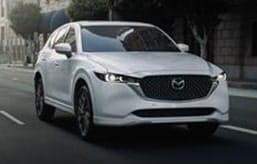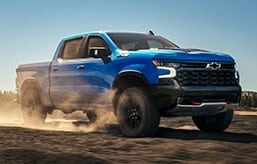- The 2022 Mazda MX-30 covered 114 miles in Edmunds' real-world EV range test.
- That's not much, but at least it's more than the EPA-estimated range of 100 miles.
- The MX-30 is also the least efficient single-motor EV we've tested to date, although it's not as inefficient as the EPA thinks.
TESTED: 2022 Mazda MX-30 Barely Tops 100 Miles of Range
But at least it's more efficient than a Tesla Model S Plaid, contra the EPA
In a world of 500-plus-mile range Lucid Airs, quad-motor Rivians and record-breaking Teslas, it's a really tough time to be the new kid at the party, especially if you're the 2022 Mazda MX-30. If you hadn't heard Mazda is making EVs now, it's probably because the MX-30, on the surface, doesn't do anything particularly well. It's a $33,470 (before tax credits), 143-horsepower front-wheel-drive EV with an EPA-estimated range of just 100 miles. And it's less efficient than Tesla's 1,020-hp tri-motor Model S Plaid … wait, what?!
That's right. According to the official EPA rating, Mazda's tiny subcompact SUV-ish runabout consumes more energy, at 37 kilowatt-hours per 100 miles, than Tesla's thousand-horsepower land rocket at 33 kWh/100 miles. To cap it off, the MX-30 is breaking records on the other end of the spectrum, requiring a segment-trailing 9 seconds to accelerate to 60 mph. Holy snail trail, Batman!
Here are the full results from the MX-30's run on our real-world EV range loop.
Testing the MX-30 in the real world
Edmunds tests every new electric vehicle on the same real-world driving loop to see just how far it can travel from a full charge down to zero miles remaining. If you scroll through our EV range leaderboard, you'll see that most EVs have matched or exceeded their EPA range estimates in our testing. Much of that has to do with our ability to test in near ideal conditions year-round.
Notably, the MX-30's battery is rated at a modest 35.5 kWh, making it the next-smallest we've tested after the Mini SE hardtop's at 32.6 kWh. Our MX-30 test car was a fully loaded Premium Plus package model ($38,550), equipped with 18-inch wheels and all-season tires (Bridgestone Turanza EL440 215/55 R18) at all four corners, inflated to the factory-recommended pressure of 36 psi. It weighed in at 3,665 pounds, which gives it one of the least favorable power-to-weight ratios (1 horsepower for every 25.6 pounds) of any EV on sale today. For context, even a base-engine Mazda CX-30, which shares the MX-30's foundation, only has 17.9 pounds to move for every 1 horsepower its engine creates.
Over the course of a day of driving at a slightly nippy average temperature of 55 degrees, we managed to travel a total of 114 miles, 14 miles more than the EPA estimate. That also equates to 14% more range than its EPA estimate, of course, which is a decent result if you prefer to analyze in percentages. But that still pales in comparison to the next-shortest range we've observed, which was 150 miles in the Mini Cooper SE against an EPA estimate of 110 miles (a 36% improvement). No matter which way you slice it, really, the MX-30's range gets a sad trombone by today's standards.
How efficient is the MX-30?
While the MX-30's range, or lack thereof, will likely be what people focus on most, energy consumption is an important factor as well. Energy consumption is what determines how much your miles will cost you. The unit of measurement for consumption, the kilowatt-hour, can be thought of as the EV equivalent of a gallon of gasoline. Just like gas, the price of electricityvaries depending on where you live. For example, you'll pay about 10 cents per kWh in Washington as of this writing, whereas in Hawaii it'll run you about 34 cents.
So, does the MX-30 actually use more energy per mile than the Tesla Model S Plaid? Recall that the EPA projects a consumption rate of 37 kWh per 100 miles for the MX-30 versus 33 kWh/100 miles for the Plaid. That's not what we found. After charging the MX-30 back to full, we calculated an efficiency of 29.6 kWh/100 miles, which is 20% more efficient than the EPA consumption figure. The Model S Plaid boasts an incredible combination of performance and efficiency, using only 32.1 kWh/100 miles in our real-world test, but the Mazda saves itself from embarrassment in this case.
Model S aside, how does the MX-30 stack up against the rest of the EV field? Not so well, it turns out. Of all the EVs we've tested to date, the Mazda is the least efficient single-motor EV and less efficient than some equipped with dual electric motors, such as the Tesla Model 3 Long Range and the Tesla Model Y Long Range. It's also less efficient than the full-size Mercedes-Benz EQS 450+ and is tied for efficiency with our drag-race-winning long-term Model Y Performance.
Yikes.
So how much does it cost to charge up an MX-30?
Using the Edmunds observed consumption rate of 29.6 kWh/100 miles, if we lived in Hawaii, our 114-mile trip in the MX-30 would have cost us $11.47, while if we lived in Washington, that same trip would cost just $3.37. If we compare the MX-30 to its most efficient competition, the Hyundai Ioniq Electric (20.8 kWh/100 miles), the same 114 miles would have cost $8.06 in Hawaii and $2.37 in Washington. In other words, in the state where electricity is most expensive, you're looking at paying 3 cents per mile more driving the Mazda over the most efficient alternative.
What about the MX-30's gasoline-powered equivalent, the CX-30? As noted, the CX-30 is similarly sized but lighter by about 300 pounds and is a lot more affordable, starting at an MSRP of $24,050. Its base engine, a naturally aspirated 2.5-liter inline-four, develops 186 horsepower, runs off regular fuel, and is estimated to return a decent 28 mpg in combined driving with front-wheel drive. Driving it for 114 miles would have set us back $17.91 in Hawaii ($4.40 per gallon) and $16.12 in Washington ($3.96 per gallon) at current prices, assuming we got the CX-30's combined mpg.
Based on these numbers, you could save an estimated $565 per year in Hawaii and $1,118 per year in Washington by driving an MX-30 for 10,000 miles instead of an CX-30. We doubt any MX-30 owner will be covering that kind of ground in a year, so looking at it on a per-mile basis, you'd be saving about 6 cents in Hawaii and 11 cents in Washington. It's interesting that the MX-30 is still cheaper to "refuel" despite its relative inefficiency compared to other EVs. At today's electricity prices at least, EVs are simply a much better value per mile when it comes to fuel costs.
For more information on how we test EV range and how each vehicle performed, we invite you to visit our Real World vs. EPA testing page, which includes both our EV range leaderboard and a table with detailed test results. Our EV range leaderboard is embeddable and will automatically update every time we add a new vehicle.
Edmunds says
The 2022 Mazda MX-30 validated its EPA range estimate in our testing and thankfully wasn't anywhere near as inefficient as the EPA said, but it's sadly still a jack of few trades and a master of none. Its limited range and market availability (it's currently offered only in California) will certainly make it a rare presence on the road. The MX-30 does have some redeeming traits, including a surprisingly quiet and upscale cabin, excellent handling dynamics and a generous amount of cargo space for its size. Perhaps the plug-in hybrid version that's due out at a later date will make more sense. For our latest comprehensive ratings of all electric vehicles, head over to Edmunds' EV rankings page.





 by
by